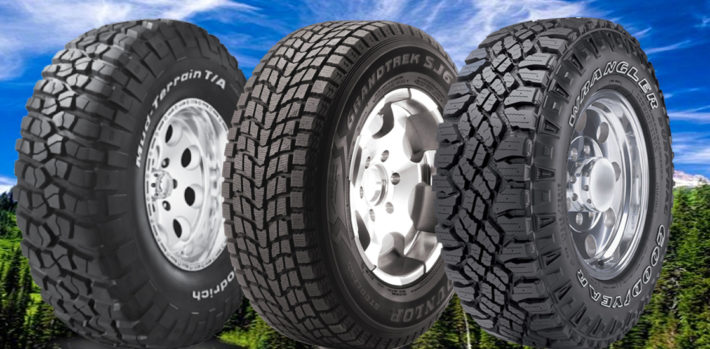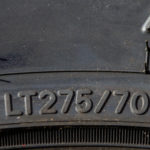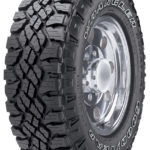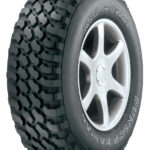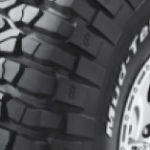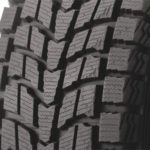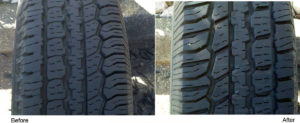Most people know the basic types of tread designs just from seeing them on trucks, but many don't actually understand how the different aspects of tread design affect your traction.
The first thing you need to know about tires found on trucks and SUVs is whether they are rated "P" for passenger car or "LT" for Light Truck. "P" rated tires are often found as original equipment on SUVs, but they typically have thin sidewalls and minimal reinforcement under the tread. These tires will not stand up long to back road use, as they will either get punctured or will get "bruised". Bruising results in dangerous weak spots that often show up as bulges in the sidewall or tread, and can cause sudden catastrophic failure of a tire.
Most LT rated tires will fall into the categories of All Season, All Terrain, Mud Terrain, or Winter Tires. The primary differences between the types are rubber compound, siping, size of tread blocks and void space, and the way the tread design channels water, dirt or mud from under the tire.
Rubber compound choices used to be simply Hard for all season tires or Soft for winter and high traction tires, however new tire technology allows tires to be somewhat responsive to the temperature outside. That said, the types of tires that the average back-country explorer is likely to use don't tend to be that complicated. A softer tire will give better traction, however it will wear out faster. To get an idea how hard or soft a tire is just look at the wear rating or tread life warranty given by the manufacturer.
The size and shape of tread blocks and void space has a profound impact on the performance of a tire on and off road.
On dry pavement your traction comes directly from how much rubber is on the road. This is why performance cars have tires with very minimal tread at all.
When it's raining the first order of business is to get the water out from under the tire so the tire doesn't get lifted off the road, or "hydroplane". Tires with shallower tread designs tend to do this with V shaped channels to direct the water to the sides. Tires with deeper treads often trust that the depth and width of the space between the tread blocks will be enough to do the job, and some tires combine both methods.
On dirt things get a bit more complex. Larger void spaces than you would see on an All Season tire are needed to keep the tires from clogging with dirt, and the need to avoid sliding sideways when the trail tilts to one side requires tread blocks that interlock and have a number of surfaces that face the side of the tire. All terrain tires usually have this style of tread so they can give reliable and predictable traction on nearly any surface.
In mud it's all about how well the tires clear the tread. Big tread blocks with large spaces between them are needed, so other design considerations take a back seat. Extreme mud tires even have a scoop built into the leading edge of the tread blocks to better dig through the goo. The problem with these designs is that their lack of sipes and minimal resistance to slipping sideways can make them unpredictable in other situations.
The type of tread that works best for rock varies greatly with the rock surface, and can change every few feet. On dry rock you want a lot of rubber contact. On wet rock you need siping. Wet or dry, the number one consideration is having a tire with thick enough sidewalls to resist being cut apart by the edges of the rocks. It is also important to have a tire that flexes well so it can maintain as much contact with the irregular surfaces as possible. Some of the more highway-friendly All Terrain tires fall down on this requirement because their harder rubber compounds don't flex as well as they could.
In the past few years we have seen the appearance of "Side Biters" on off-road tires. These extra tread blocks that extend down the sidewall of the tire serve the dual purposes of protecting the sidewall from damage and letting you get some grip when only the side of the tire is touching the ground. This can be a huge boost to traction, especially on dirt and firm mud.
Siping is one of the least understood factors in tire traction. Sipes are the small slits in the tread of a tire. Most winter tires will have a lot of sipes, and All Season or All Terrain tires will have at least a couple of sipes on each tread block. On slippery or icy roads, smooth wet rocks, or wet logs your traction comes from the sipes. Each one is a little squeegee cleaning the water away and grabbing the surface underneath.
What if you already have tires that aren't quite right, or you want the big tread blocks of a Mud Tire with the siping of an All-Terrain? There is an answer. Grooving and siping tires to change the tread pattern is becoming a lost art, but it is still common with commercial truckers and hard-core wheelers. You can either take your tires to a commercial truck tire store that has a siping machine, or buy a "Hot Iron" and sipe them yourself. You should know that modifying your tires may void any warranty on them, and you should never ever cut into the tires deeper than the top of the wear bars. It is also critical to keep the cuts even and equal so as not to unbalance the tire.
My personal choice of tread design is to take a reasonably street friendly Mud Tire and add a lot of sipes to it to improve traction on wet and slippery surfaces. I find it to be the best compromise for all types of back-road driving and they can be used on the street year round if you drive with caution.
Photos from Goodyear.ca, BFGoodrich.ca, Interco.com

